mytest
eBooks, Books, and more from ARUDOU Debito (click on icon):
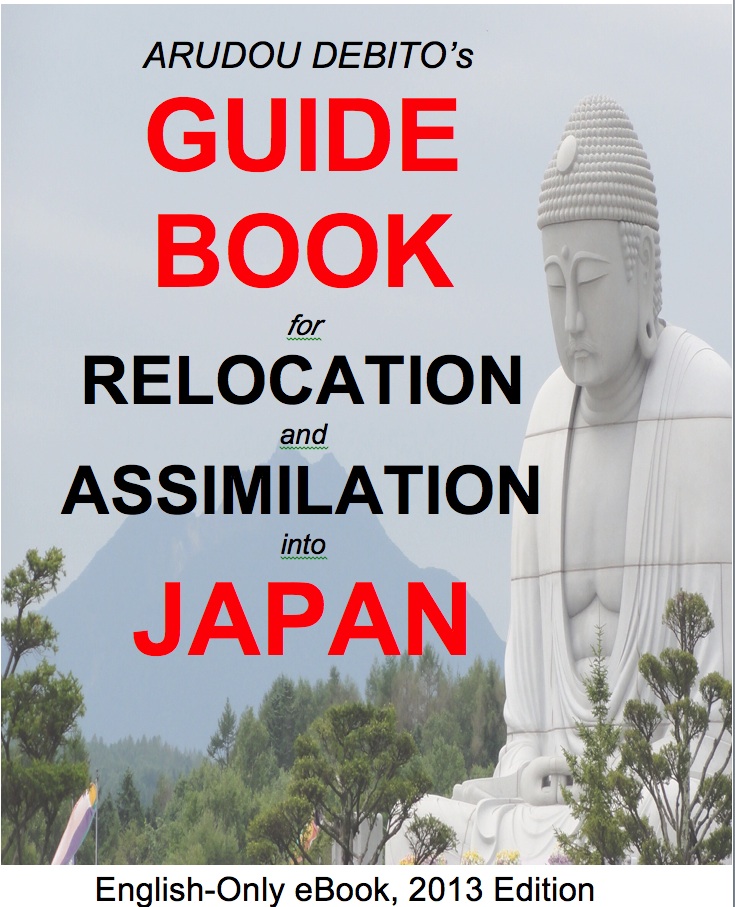
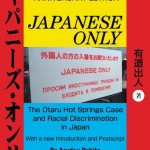
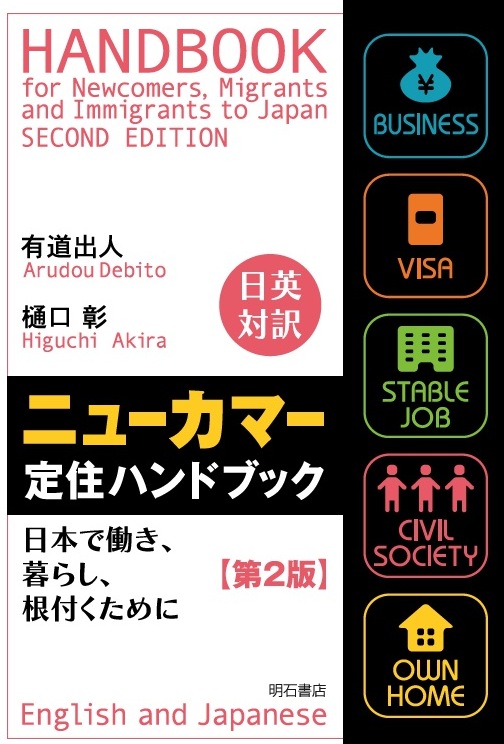


![]()

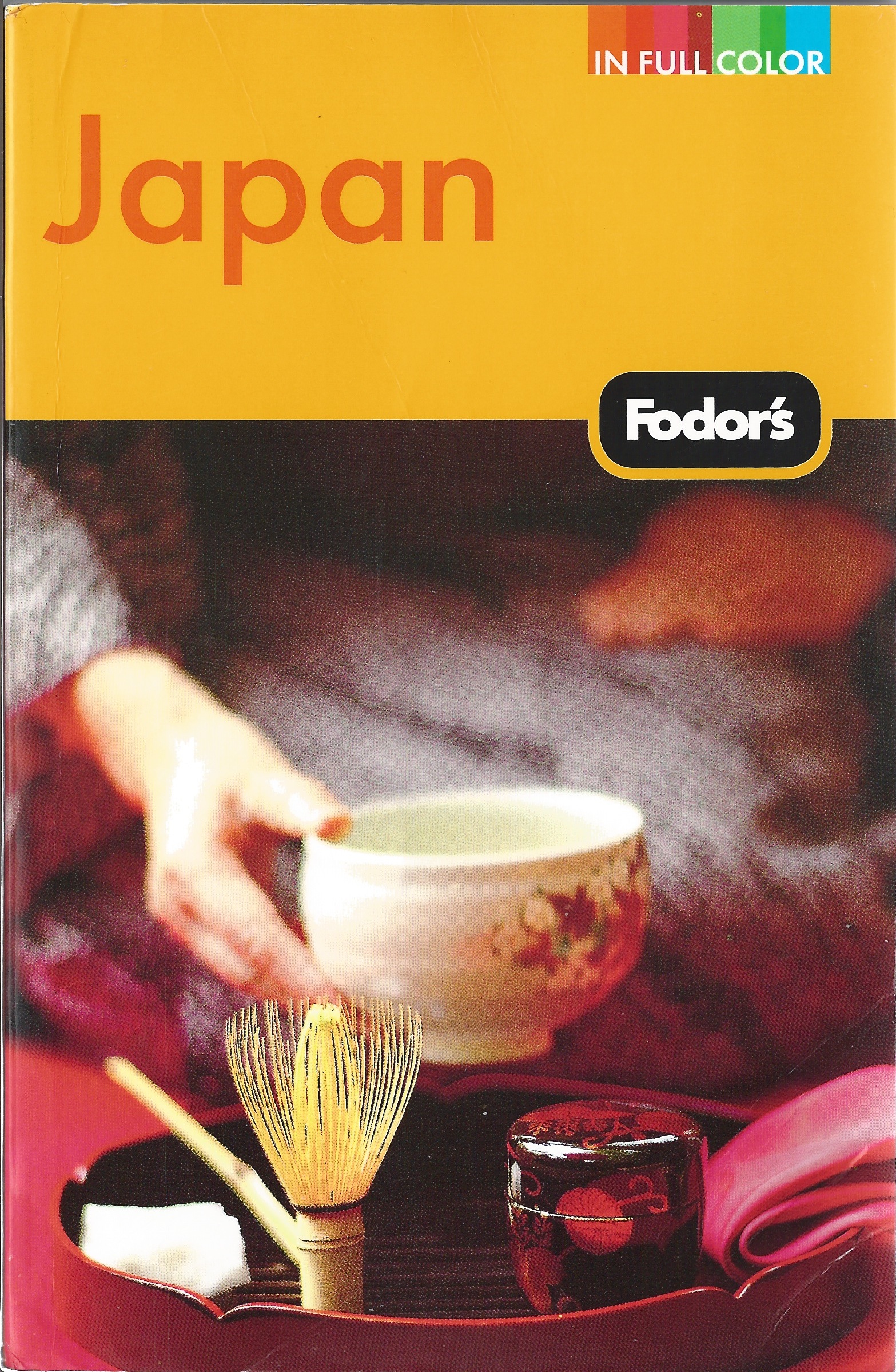
UPDATES ON TWITTER: arudoudebito
DEBITO.ORG PODCASTS on iTunes, subscribe free
“LIKE” US on Facebook at http://www.facebook.com/debitoorg
http://www.facebook.com/handbookimmigrants
https://www.facebook.com/JapaneseOnlyTheBook
https://www.facebook.com/BookInAppropriate
If you like what you read and discuss on Debito.org, please consider helping us stop hackers and defray maintenance costs with a little donation via my webhoster:

All donations go towards website costs only. Thanks for your support!
Hi Blog. As noted in the Japan Today article cited below, SAPIO debate magazine (June 2014) devoted an issue specifically to the issue of immigration (imin) to Japan (what with the Abe Administration’s renewed plan to import 200,000 NJ per year).
Good. But then it fumbles the issue with all manner of narratives that microaggress the NJ immigrant back into a position of being powerless and voiceless. First, let’s start with SAPIO’s cover, courtesy of MS:
COMMENT: Notice anything funny? Start with the sub-headline in yellow talking about having a vigorous debate from “each world” (kyaku kai). Each? Look at the debaters being featured in the bubbles. See any Visible Minorities there? Nope, they’re left out of the debate once again. All we get are the typical powerful pundits (probably all Wajin, with “Papa Bear” Wajin Ishihara second in line). , Where is the voice of the immigrant?
And by “immigrant”, I mean people who have immigrated to Japan as NJ and made a life here as long-term resident if not actual Permanent-Residency holder. The people who have indefinite leave to remain. The “Newcomers“, who work in Japan and work for Japan. As depicted in the picture of the labor-union demonstrators in the inset photo in the top right.
Now look at the larger photo. It’s a xenophobic demo about issues between Japan and Korea (and no doubt China). That’s not a debate about immigration. It’s a hate rally airing historical grievances between Japan and it’s neighbors, gussied up as a jerry-rigged issue about “Zainichis having special privileges as NJ” (the very root complaint of the Zaitokukai group, which, even if those “special privileges” were meaningfully true, ought to happen anyway what with all the contributions the Zainichi have made to Japanese society both as prewar citizens of empire and postwar disenfranchised residents for generations; but I digress). Anyway, the point is that the cover does not convey the issue of “immigration in Japan” accurately. Zainichi issues dominate.
Finally, note how all the Wajin demonstrators have their faces blocked out in the photo. Clearly Wajin have privacies to protect. Not so the NJ protesting in the photo inset. Hence NJ once again have fewer rights to privacy in the Japanese media. Just like this photo from the racist Gaijin Hanzai Magazine of yore (remember that? more information here). Comparative powerlessness in visual form.
Next up, check out the Japan Today writeup on the SAPIO special:
////////////////////////////////////////////////////
Consultant urges ‘one-of-a-kind’ immigration policy for Japan
JAPAN TODAY KUCHIKOMI MAY. 12, 2014 – TOKYO —
http://www.japantoday.com/category/kuchikomi/view/consultant-urges-one-of-a-kind-immigration-policy-for-japan, courtesy lots of people
In its cover story for June, Sapio devotes 14 articles—including a contribution by former Tokyo Gov Shintaro Ishihara—and 23 pages to wide-ranging discussions on the subject of immigration. It looks like substantial changes are coming, and coming soon. What form should immigration take? What are the merits and demerits?
Management consultant Kenichi Ohmae is, if anything, a pragmatic person. He also expresses his ideas logically and persuasively, and he has devoted a lot of thinking to the issue of immigration, which he suggests be adopted as a policy in three successive stages.
First of all, the demographics don’t lie: by 2050 the largest age segment in Japan’s population pyramid, both for males and females will be those in their late 70s, with fewer and fewer younger people. If this course is maintained, people in their productive ages will decline rapidly. Ohmae says he pointed this out more than 20 years ago. During his past four decades as a business consultant, he has observed that in general, introduction of foreign workers in Japanese businesses has been carried out in five-year increments, during which time problems and challenges are resolved through a trial-and-error basis.
When one looks back 25 to 30 years, to the economic “bubble,” Japan found itself with a labor shortage, particularly in construction and manufacturing. It began bringing in “Nikkeijin” (people of Japanese ancestry) from Latin America, along with Pakistanis, Iranians and others. Since there was no visa status for manual laborers, they entered on tourist or student visas, and the government feigned disinterest when they took blue-collar jobs.
Then the bubble collapsed, and these workers were summarily dismissed. The number of illegal foreign workers declined, and Japan was soundly criticized for its lack of interest in the workers’ welfare.
The current Abe government appears inclined to issue guidelines that will expand entry by foreign workers in such fields as construction, nursing care, agriculture and household domestics. On the other hand, it’s proceeding with measures to ensure that the entry of such foreigners not be mistakenly construed as “immigration policies.” In other words, time limits will be imposed on those workers’ stays. Inevitably, this will result in a repeat of the mistakes and troubles that happened after the collapse of the bubble.
Considering that the Japanese babies being born now will take from 15 to 30 years before they start contributing to Japan’s economy, it’s clear that immigration offers Japan’s only hope to preserve its economic vitality. And, Ohmae emphasizes, now is probably its last chance to take meaningful action.
The three stages Ohmae proposes are: First, Japan should emulate Silicon Valley in attracting 1,000 skilled people a year from such countries as Israel, India, Taiwan, Russia and East European countries. But these people should not be limited only to the field of Information Technology. They would be concentrated in six “clusters” around the country, mostly in large urban areas where they and their families would be made to feel at home with access to churches, schools and so on.
The second stage is to find a way to attract 100,000 professionals a year in the category of work titles with the “shi” suffix (such as “kangoshi” or nurse), trained care providers, attorneys, firemen, etc), all of which are currently in short supply.
The third stage is to accept blue-collar workers, of whom at least 300,000 per year will be needed to keep Japan’s economic engine purring. Ohmae suggests the Japanese government set up and fund preparatory schools in countries likely to supply labor, where students can learn the basics of the Japanese language, laws, customs, and so on before they arrive. And passing an examination will entitle them to a Japanese-style “green card,” permanent residence and the right to work. Such a system is likely to help avoid concentration of unskilled foreigners who would gravitate to the slums that have created social problems in other countries.
When considering the future of immigration, Ohmae also urges the importance of avoiding its politicization among Japanese, so that when people debate its pros and cons, this can be done dispassionately, without tarring one another with “right wing” or “left wing” labels.
ENDS
////////////////////////////////////////////////////
COMMENT: Although unusually well-intentioned (check out his paternalistic and misogynistic attitudes about Burmese and Aung San Suu Kyi in 1997’s SAPIO), Ohmae, despite his verbal distancing from Japan’s perpetual “Revolving Door” visa regimes, fundamentally recycles the same old ideas about bringing in brainy NJ (unscientifically linking job skills with thoroughbred nationalities/ethnicities and sequestering them in their own enclaves, once again), with no apparent suggestion about making these immigrants into Japanese citizens. Well, we don’t want to give them too much power to actually have any say over their own lives here. NJ can come here to work so that we Wajin can stay economically afloat, but that’s all. They shouldn’t expect much more than the privilege to work and stay in our rich country for as long as they’re needed.
I’ll leave the readers to parse out all the unconscious “othering NJ” microaggressions for themselves, but, ultimately, the question remains: Where is the specialist commenting on “immigration” (there are people well-studied in that science; try the United Nations) who will lend a specifically-trained viewpoint to the debate, instead of the same old, hoary Wajin pundits defending their ideologies?
Finally, consider the opening editorial article in SAPIO below, which explores the issue of discrimination in general in Japan. Despite the title (which rightfully talks about hate speech towards Zainichi Koreans and Chinese as shameful for a first-world country), it opens with some soul-searching about the Urawa Reds fans’ “JAPANESE ONLY” banner in Saitama Stadium as an example of Japan’s discriminatory attitudes. Fine. But then the article is hijacked once again by the (very important, but not complete) issues of domestic discrimination towards the Zainichi.
Remember, this is an issue also devoted to IMMIGRATION. The numbers of the Zainichi Koreans and Chinese (i.e., the “Oldcomers”) have been dropping for many years now. They are not the immigrants of note. The immigrants, as I defined above, are the NEWCOMERS. And once again, their voice is not represented within the debate on discrimination or assimilation in Japan. Those minorities, particularly the Visible Minorities, are silenced.
What’s particularly ironic in the citation of the Urawa Reds’ “Japanese Only” banner is that IT WOULD NOT HAVE AFFECTED THE ZAINICHIS. “Japanese Only” as a narrative very specifically affects those who do not “look Japanese“. Thus any Zainichi in Saitama Stadium that day would have “passed” as “Japanese” on sight identification, and could have chosen to sit in those exclusionary stands. Thus SAPIO, like just about all Japanese media I’ve ever seen, once again crosses its analytical wires, and with these narratives riddled with blind spots and microaggressions, Japan’s “immigration” issue will not be resolved.
That said, I think PM Abe knows this. That’s why his administration is going back to bribing Wajin to have more babies. More on that here courtesy of JK. Dr. ARUDOU, Debito
ENDS
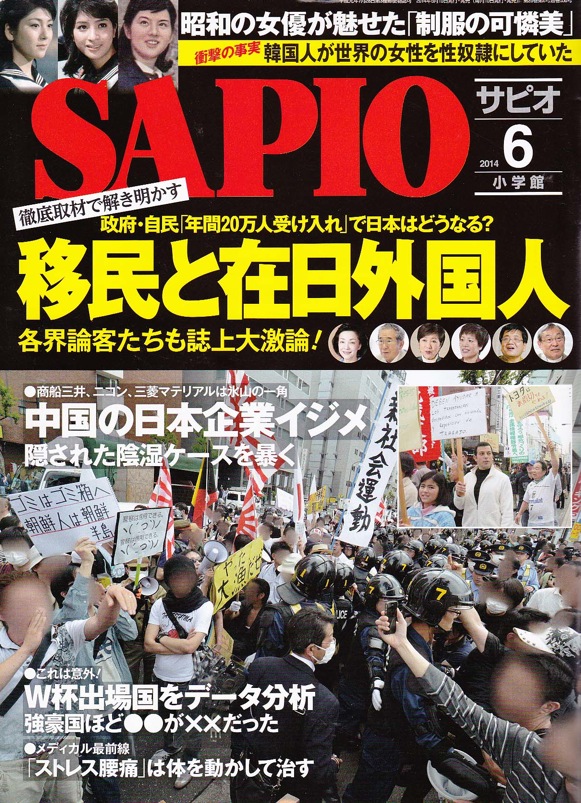
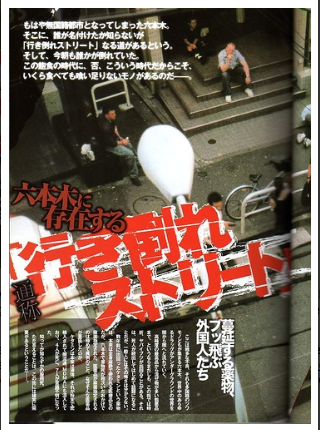
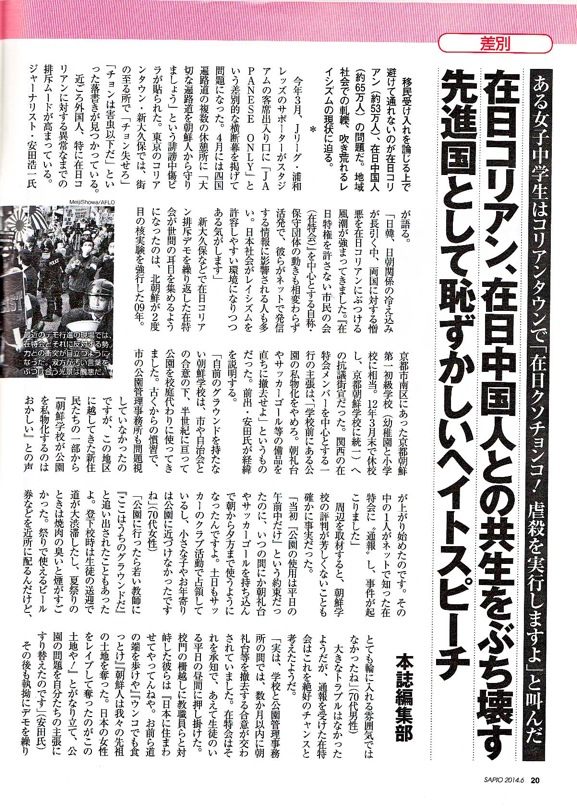
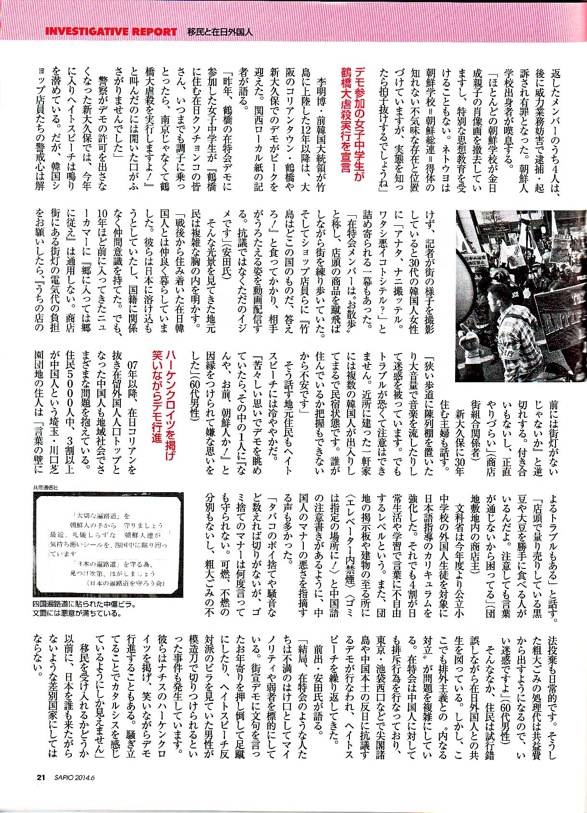
21 comments on “SAPIO Mag features special on Immigration to Japan: Note odd media narratives microaggressing NJ (particularly the Visible Minorities) into voiceless role”
Good thread Doctor!
I’ll get back to you with a comment on immigration, but quickly want to give you a thought on this;
‘I think PM Abe knows this. That’s why his administration is going back to bribing Wajin to have more babies. ‘
Yes, I agree. He will tell them it’s their patriotic duty to save the future of the Japanese nation! And a bonus side effect is that it will stop them getting ‘western’ ideas about equality in the workplace, since they will be in their traditional ‘mother’ role.
Quite honestly, the first funny thing I noticed was the “Shocking Truth: Koreans Turned the World’s Women into Sex Slaves” headline.
It’s really hard to take anything seriously after reading that. Isn’t Sapio more-or-less a right wing publication? It focuses a lot on Chinese/Koreans, anti-Japanese demonstrations, etc., no? Even if that particular issue claims to report on the vigorous debate from pundits representing random fields (I’m assuming by ‘each world’ they mean every sphere as in economic sphere, political sphere, etc.), one should just assume that it’s going to cater to the right and be as ‘Fair and Balanced’ as Fox News.
As disturbing as it is having niche magazines like Sphere spreading its nonsense, it’s just preaching to the converted. Is it worth the time and energy to even acknowledge it?
**For the sake of full disclosure, I haven’t read the actual article. I’m just judging the book – err – magazine by its cover.**
Ok, I’ve had time to digest the Sapio stuff.
I would say in answer to Irezumi_Aniki that it is indeed a magazine that we would consider to pander/incite the fears of the right on a regular basis.
With that knowledge in mind, let’s consider the magazines obsession with linking the Zainichi Korean issue with it’s proposed objective of discussing the immigration debate, as highlighted by the good Doctor.
It seems to me that this is a pretty obvious attempt to generate anti-immigration sentiment amongst it’s right-wing readership (not that I would believe that any of them would need further persuasion). Glossing over the fact that the Zainichi Koreans (as has been pointed out here before) were;
1. Generally brought/coerced to come to Japan by the Japanese in the first place.
2. Disenfranchised by loss of Japanese citizenship at the end of the war.
3. At this point (what, 3rd? 4th generation?) they would be considered legitimate nationals had they been born in any other G20 country.
I would posit that the underlying aim of the article (after all, even Blinky Ishihara isn’t raining alarm bells!) is to propose an immigration policy that;
1. As Dr. Debito identifies, continues to pine for the imaginary ‘elite gaijin’ who are still (although God knows why) imagined by policy-makers to be desperate to settle in Japan.
2. Again, as Dr. Debito has recognized, Japanese nationals can rest assured that in the (fantasy?) event that these thousands of ‘elite gaijin’ come to Japan, they could be placed in a modern day ‘Dejima’ enclaves that would separate them from the everyday lives of decent Japanese people (no ‘meiwaku gaijin’ here, then).
3. And again, these ‘elite gaijin’ with internationally demanded skills, and financial independence, will not be expecting (nor indeed, should the receive!) anything like social rights, citizenship, the vote, freedom from discrimination, etc.
Hmmm, didn’t work out so well a couple of years ago, why do they think it will work now?
And anyway, Japan doesn’t need ‘elite gaijin’. It needs people to work in the construction industry and farming, and combini’s, and other KKK jobs the Japanese won’t do (although, with reference to construction and farming, I would say that the alleged ‘need’ is a self made symptom of the ills of the Japanese system, and should quite rightly, be dismantled).
So, why this preoccupation with the ‘elite gaijin’ living in ‘elite gaijin bubbles’ with minimized social contact/effect in Japan?
Because the magazine is drawing a subconscious contrast (which it hopes to elicit in it’s readers) between the ‘good gaijin’ of Japanese fantasy that the likes of Ishihara say that Japan needs, and the ‘bad gaijin’, represented here by the Zainichi Koreans.
Why have the Zainichi Koreans been labelled as ‘bad gaijin’ in the right-wing’s popular imagination? Well, here’s a thought, they serve as a example from the past of how Japan tried to use immigration to sole labor shortages in all of the areas (except combini’s) that I listed above- Japan’s ‘Immigration 1.0’, if you like. Which was fine when the Zainichi Koreans were part of the Imperial Japanese social structure, because there were laws, rights (or lack thereof), and a whole national ideology to keep them in their place in a Japan that was resisting global pressure by the use of force. Must have been a ‘Golden Age’ for all those right-wing loons (well, in fact, we know that’s exactly how the likes of Abe, Ishihara et al imagine it).
Problem was that losing the war, and the removal of all those safeguards that Imperial Japan had to keep the Zainichi Koreans in their place, didn’t just set the Zainichi Koreans free, it meant that in the eyes of the world, they were ‘people’ with just as much value as a Japanese person! Oh, the shame of it! Added to which, is the shame (humiliation?) of being told that your effort to liberate your asian brothers and sisters actually was a genocidal attempt to enslave Asia.
Of course, this is the cause of a massive cognitive dissonance for right-wingers, leading them to believe in all sorts of bizarre revisionist narratives and theories, and grasp at straws from all sorts of odd places (Scott-Stoking!), as most sufferers of cognitive dissonance do, in order to attempt to reconcile their clashing world-view with the facts that they are presented with. Further, and further down the rabbit-hole they go!
So, there we have it. Sapio is framing the immigration debate, in the minds of it’s readers thus;
‘Japan should accept those rich and highly skilled NJ provided they can be isolated from society in bubbles, and denied any ability to exert influence on the way ‘we Japanese’ do anything. After all, Japan kindly allowed all those Koreans to come here to share in our economic prosperity back in the day, and they just took advantage of Japan, and now we’re lumbered with the trouble-makers! Won’t make that mistake twice!’
Problem is, that Japan’s economic and demographic time-bomb means that all mistakes made this year or next will likely be ‘for the last time’.
Japan is the Titanic. It hit the iceberg 2 hours ago. The water is flooding in. The water can’t be stopped. There aren’t enough lifeboats for everyone.
@Irezumi_Aniki, #2
Yes. SAPIO is one of the right-learning weekly magazines popular in Japan. As you can guess, they are pretty much critical of China and Korea on international relations, having neo-conservative folks like Yoshinori Kobayashi and a bigoted female journalist Yoshiko Sakurai.
http://ja.wikipedia.org/wiki/SAPIO#.E5.86.85.E5.AE.B9
A bit off topic but speaking of micro-aggressions, you might want to check out this youtube clip. I don’t know whether to laugh or cry:
https://www.youtube.com/watch?v=oLt5qSm9U80
— Very painful. Nice to see Stefhen there.
The thought of Abe bribing JP to have more babies is very amusing. Good luck with that. The only way that will happen is if the administration convinces big biz that a metropolitan address is uneconomical. When 50%+ of your citizenry live in 5 cities (25% in Tokyo alone!) the movers and shakers of those cities have a lot of oomph. As it stands today, what Tokyo wants, Tokyo gets. Since Tokyo is just too expensive to have even one kid, much less 3, the population collapse will persist. I can just imagine how the land owners of Tokyo would react to any policy which will incentivize companies to move to the countryside in order to give their workers more lebensraum so they can afford more than 2 kids. A very Gordian knot, says I. Raising taxes on megacity dwellers and lowering them in smaller communities will only increase commute times.
Back in Soviet days, the USSR gave women with more than 7 kids a special pin (Heroines of the USSR) which allowed them to go to movies free, go directly to the front on any line, ride the subway for free, etc. I’m thinkng JP could do the same with families with more than 3 kids.
Yes, it’s extremely frustrating to see a “debate” that excludes any contribution by NJ; we exists only as objects and a problem to be dealt with. It’s fundamentally exclusionary and sadly ironic. SAPIO couldn’t even be bothered with a token gaijin. Where I work, I have a token say, as long as I submit and get shafted with a smile anyway.
#3 Jim –
Japanese people have convinced themselves that they are better than other Asians – especially Koreans and Chinese. They often measure themselves by comparing Japan to Korea or China.
When stressed, many Japanese mock, belittle, or outright insult Koreans and Chinese – it is safe, makes them feel better (and no one will push back).
Kenichi Ohmae’s proposal, like previous plans to encourage elite foreigners to visit or move to Japan, will fail –
a. partly because Japan just does not have that much to offer, long term (it is not the land of opportunity) to entice large numbers of educated people to move to Japan to become low-paid 2nd class citizens, not accepted by the locals, and
b. because the majority of Japanese people DO NOT want to compete with non-Japanese people for jobs, housing, etc.
c. like all such plans, it is a top-down plan – it does not ask what would motivate foreigners to embrace Japan. It does not anticipate a different point of view, or attempt to integrate immigrants. And it does not require an actual foreigner be involved in helping to develop said plan.
The bottom line: Japanese culture demands conformity. The power elite, government, media, the population at large – all forces in Japan are not comfortable with large scale immigration to Japan. Foreigners inevitably bring their culture, and this disrupts the WA. Can’t have that.
Ah, the voice of reason!
I like this guy, he spoke out a couple of months ago and said Japan needs 200,000 NJ immigrants a year to maintain 1,000,000 population base.
Now, he’s slamming the latest proposal for increasing birth-rate and the trainee program.
http://www.japantimes.co.jp/news/2014/05/16/national/population-fixes-have-anti-foreign-bias-official-says/
No one will listen to him, I’ll bet.
— Sakanaka? Debito.org has been listening to him for years.
NATIONAL
Population fixes have anti-foreign bias, official says
BY TOMOHIRO OSAKI
STAFF WRITER THE JAPAN TIMES MAY 16, 2014
The government is in denial over Japan’s looming demographic disaster and adopting unrealistic solutions rather than face the need to accept large numbers of immigrants, a former senior immigration official said Friday.
Hidenori Sakanaka, a former director of the Tokyo Regional Immigration Bureau who now heads the Japan Immigration Policy Institute, said his voice has long gone unheard because an anti-immigration culture exists among Japan’s intellectuals and media.
Speaking at the Foreign Correspondents’ Club of Japan, Sakanaka said that policies such as trying to push the elderly and more women into the workforce to combat shrinkage shows “the government’s desperate desire to avoid opening up their nation to immigration — at all costs.”
On Tuesday, an advisory panel to Prime Minister Shinzo Abe said in an interim report that the government should focus on raising Japan’s birthrate to save the nation from an impending crisis of shrinking towns and workforces.
For Japan to maintain a population of around 100 million over the next 50 years, the report said that Japan’s fertility rate must rise to 2.07 percent from the current 1.41. But it also said it would not recommend the wholesale acceptance of immigrants to forestall the projected decline in the population — as Sakanaka advocates.
He told the audience in Tokyo that he believes Japan should become, over the years, a “nation of immigrants,” dismissing the panel’s suggested goal of boosting the birthrate to 2.07 percent as “unfeasible.”
“Not just Japan, but all other advanced and civilized countries are facing reduced birth rates. I don’t think achieving a 2.07 percent birthrate several decades, or even 100 years from now on, is possible. There are so many unknown elements,” he said.
Sakanaka also condemned Abe’s plan to expand a contentious foreign-trainee program to prevent labor shortages ahead of the 2020 Tokyo Olympics. Experts say unscrupulous employers often exploit such trainees.
They allegedly use the program to obtain cheap labor, which often opens the door to other abuses. Currently the trainees can obtain a three-year visa, but government now plans to allow them to stay for two additional years.
Calling it an “incarnation of modern-day slavery,” Sakanaka said the planned expansion will “only be remembered as an embarrassment.”
ENDS
Thought I’d pass along some related articles plus my two-yen at no charge:
Japan aims to keep population at 100 mil. 50 years later
http://mainichi.jp/english/english/newsselect/news/20140513p2g00m0dm072000c.html
Japan aims to keep population at 100 mil. 50 years later
May 13, 2014 (Mainichi Japan)
TOKYO (Kyodo) — A government-appointed panel on Tuesday proposed measures to halt the slide in the country’s population from the current 127 million and stabilize it at around 100 million in 50 years’ time.
The panel’s preliminary report is expected to prompt the government to establish the first numerical target for the country’s population, officials said.
Japan’s population is projected to fall to about 87 million in 2060 if the nation’s birthrate remains low. The country will need to work out new policies to slow the decline in population as it would seriously affect its economic and fiscal situation.
During the panel’s meeting on Tuesday, economic and fiscal policy minister Akira Amari said the government plans to reflect the proposals in its guidelines on economic and fiscal policies to be released in June.
The panel, led by Akio Mimura, chairman of the Japan Chamber of Commerce and Industry, was set up under the 11-member Council on Fiscal and Economic Policy headed by Prime Minister Shinzo Abe, and has been discussing Japan’s medium- and long-term goals.
“We hope the government will share our sense of crisis,” Mimura told reporters after the meeting.
It estimated that if Japan’s total fertility rate — the average number of children born to a woman — recovers to 2.07 in 2030 from 1.41 in 2012 and stays at that level, the country’s population will be 105.45 million in 2060.
In the report, the panel called on the government to double its support for parents rearing children. It also called for efforts to encourage senior citizens to work and widen the country’s working age parameters from 15 to 64 at present to 15 to 70.
Noting that the birthrates in Tokyo and surrounding areas are lower than those in other parts of the country, the panel called for promoting migration from the Tokyo metropolitan region to other areas.
It also suggested Japan accept more foreign skilled workers with specific know-how to boost the country’s economic growth.
ends
================================
Here’s the gist: a) bribes for having kids, b) cajole Tokyoites to plug the population holes.
The solutions on offer then begin to morph into economics: c) move the goalposts to define the working age as 70 instead of 64, d) boost the economy with desirable gaijin (skilled foreign workers), but as you’ll see in the next articles, opportunities for such individuals are constrained to modern-day Dejimas (i.e. special strategic zones) due to “deterioration of society, cultural frictions and a decrease in job opportunities for Japanese
workers”.
Not mincing any words here, Justice Minister Sadakazu Tanigaki, states, “The government should consider the adverse effects [this would have] on security.” Note that he did not leave any room for ambiguity here by saying “possible adverse effects”. How lovely, especially when it comes from the man in charge of immigration.
================================
Labor scarcity may open door to foreigners
http://the-japan-news.com/news/article/0001276869
Labor scarcity may open door to foreigners
10:45 pm, May 13, 2014
The Yomiuri Shimbun
The government is considering an expansion of programs to accept foreign workers to respond to labor shortages and maintain the strength of the economy amid a shrinking society.
However, as many government officials and ruling party lawmakers have expressed strong concern about deteriorating security, it is believed the government will only expand current training programs for foreign workers or limit their acceptance to designated special strategic zones.
After Japan’s current working-age population (15 to 64 years old) peaked at 87.26 million in 1995, it has been declining nearly every year. According to an estimate by the National Institute of Population and Social Security Research, it will fall below 50 million in 2051, the same level recorded in 1950.
The business community has urged the government to expand the acceptance of foreign workers. At a joint meeting of the Council on Economic and Fiscal Policy and Industrial Competitiveness Council, some participants said, “If the government refuses to accept unskilled labor, we cannot secure adequate human resources.” As of October 2013, the number of foreign workers in Japan was only about 720,000 people.
However, many people are negative about a full-scale acceptance of foreign workers. They are strongly concerned about the deterioration of society, cultural frictions and a decrease in job opportunities for Japanese workers. Justice Minister Sadakazu Tanigaki, responsible for immigration, said, “The government should consider the adverse effects [this would have] on security.” Prime Minister Shinzo Abe also ordered ministers with related responsibilities to consider expanding acceptance but limiting periods of stay.
The government plans to examine the economic effects and problems caused by an acceptance of foreign workers in designated special strategic zones, such as the Tokyo metropolitan and Kansai areas, and then decide whether to introduce the system nationwide. At Monday’s meeting of an advisory council on designated special strategic zones, it was decided that the government would hold further discussions on the types of jobs and periods of acceptance within the zones.
In addition, it is believed the government will review the training programs for foreign workers, in which they learn skills for agriculture, construction and seafood processing jobs while working, to maintain the labor force at a predetermined level. The scope of work and period of stay will be expanded.
For example, the government is considering extending the period of stay from three to five years, accepting past trainees who returned to their countries after completing programs in Japan and adding nursing care to the scope of work included in such programs.
ENDS
================================
New status for foreigners in strategic zones planned
http://the-japan-news.com/news/article/0001276666
The Yomiuri Shimbun
8:47 pm, May 13, 2014
The government will start considering increasing the number of foreign workers in national strategic special zones, where regulations will be drastically eased.
A new status of residency for foreigners who start a business or are employed to do housework in such zones is being planned by the government.
The plan was decided Monday at a meeting of the advisory council on national strategic special zones, chaired by Prime Minister Shinzo Abe, which was held at the Prime Minister’s Office. The government will include the plan in its growth strategy to be revised in June.
Currently, resident status allows foreigners with specific professional skills, such as lawyers, to work in Japan, or foreign trainees to receive on-the-job training.
This spring, six areas of the country were selected as national strategic special zones, including an area encompassing Tokyo and its vicinity; the Kansai area, covering Osaka, Kyoto and Hyogo prefectures; and Fukuoka. In each zone, the government will consider easing the regulations and giving resident status to foreigners who start companies and to their employees.
Also, the government plans to increase the number of foreign babysitters to help Japanese women return to work after maternity leave, with the aim of promoting women’s active participation in society.
Concerning increasing the number of foreign workers, there are strong fears that public safety will deteriorate. At the meeting, Abe said, “I know there is resistance and opposition, but I believe it is possible to drill into hard-rock regulations by continually creating additional deregulation measures based on real demand.”
-JK
– Concerning increasing the number of foreign workers, there are strong fears that public safety will deteriorate. At the meeting, Abe said, “I know there is resistance and opposition, but I believe it is possible to drill into hard-rock regulations by continually creating additional deregulation measures based on real demand.”
For “strategic zones” read gilded ghettos. We got to keep these gaijin animals caged. Who knows, they might even start breeding with us, putting down roots and demanding some sort of rights.
Here’s the list of names representing the six face pictures adjacent to the sub-headline “Guest commenters from each clique(“ka-ku-kai” engaging in vigorous debate!”
From far left:
English(Japanese)
1. Yoshiko Sakurai(櫻井よしこ)
2. Shintaro Ishihara(石原慎太郎)
3. Yuriko Koike(小池百合子)
4. Sonfa O/Seon-hwa Oh(呉善花)
5. Takuro Morinaga(森永卓郎)
6. Kenichi Ohmae(大前研一)
Technically, Sonfa is the only one among all six who has foreign cultural root(NOTE: she’s an ethnically Korean[not Zainichi] who took out Japanese citizenship in 1998.]. She’s been stigmatized as a traitor for repetitive criticism of her former country(including a recent Cruise incident)since her naturalization. Because of that, South Korean government put her in the blacklist since 2010, and eventually refused her an entry by initiating repatriation order last year.
The other five could be divided into neo-conservatives(1&2), left/socialist(3&5), and libertarian/utilitarian(6).
— Thanks for this. I’m not sure how “left” Koike would be, especially towards outsiders. Same with Oh Sonfa. Clearly SAPIO’s choice of talking heads is shooting fish in a barrel politically. They are basically, at best, two Colmes with three or four Hannitys.
Well, as for immigration policy, here’s what Abe had to say (apparently);
“It’s not an immigrant policy. We’d like them to work and raise incomes for a limited period of time, and then return home,” Abe said.
http://www.japantimes.co.jp/news/2014/05/18/national/success-abenomics-hinges-immigration-policy/
N.B. ‘return home’ is an explicit policy goal ( so what about the population shrinkage, BTW?). This policy will fail because it offers no protection, and no benefits.
@Dr. Debito
You’re right. Koike belongs to LDP. I misrecognized her with another female politician Mizuho Fukushima. Also, I think it’s safe to put Sonda Oh in the pro-LDP camp.
— So that’s it then — all SAPIO’s pundits are safely status-quo types who will offer few thoughts outside the box.
@ Dr. Debito;
‘all SAPIO’s pundits are safely status-quo types who will offer few thoughts outside the box.’
That’s for sure. But then look at the Abe’s quote above.
Despite the chronic need to solve the demographic problem (even if only for selfish tax base economic reasons), the J-Gov response is straight out of the era of Perry and the Black Ships, ‘gaijin go home- Japan for the Japanese’. They might as well be screaming ‘Sonno Joi!’, which is ironic since Abe’s proposed ‘special economic zones’ are to be ‘gaijin enclaves’ like modern Dejima’s.
It’s all looking pretty much like shin-sakoku to me!
When Abe said he was ‘Taking Japan Back!’, I didn’t realize he meant all the way to the Edo era!
@Loverilakkuma (1&) It’s interesting that you say “The other five could be divided into neo-conservatives(1&2),” (meaning Ishihara) – is this mainstream opinion in Japan?
I think in any Western country, there would be no classification for him other than “far-right fringe”, even if he shares some “ideas” with neo-conservatives. And in my own country, I am 100% sure he wouldn’t be able to work in a public office given the history of his statements and actions.
“Japan should emulate Silicon Valley in attracting 1,000 skilled people a year from such countries as Israel, India, Taiwan, Russia and East European countries.”
doesn’t that sound like putting the cart before the horse ? To replicate Silicon Valley (a phantasma which lots of countries are trying to achieve) you’d have to understand what established the “start-up culture” in that place in time, which is a combination of excellent universities and venture capital – both of which Japan lacks (compared to the original). That’s what attracted those prized elite immigrants after the fact, not before. Simply throwing them at the problem and expecting magic to happen won’t work. And let’s get real, we’re not talking here about desperate shitkickers to exploit, but people who could choose and walk in to any place at America/Europe/Asia – they’d take one good look at the japanese business enviroment and say “nah, thanks..”
You should better begin to establish a real native start-up culture, instead of inoculating your best and brightest that the highest goal in life is to land a cushy position at the big establishment. Yes, that will be a “scary” thing because there’ll be always the possibility of failure, but so be the road to progress. “Silicon Valley” and what it stands for is not the same as developmental “capitalism from above” mandates of old, like metalworking or mass manufacturing, it has to establish organically instead of the “build it and they will come” command mentality that only produces boondoggles.
“Special Economic Zones” of various kinds have been tried again and again, to not much success, it seems ? Tax breaks and subsidies only work for so much, but let’s not be surprised when you don’t get the revenue results on the other end that you wanted. And with the explicit “foreigner-angle” here, I can already see another gaijin-as-guineapigs situation arising. Firms are to be lured by the prospect of “structural reforms”, well that usually just means one thing: deregulation, and of what ? Labour standarts, safety and inspections, accountability and bookkeeping, the whole neoliberal slash-and-burn recipe. I’m not convinved that this is the solution to give the ossified ojisan-networks in Japan their well-deserved freemarket-kick in the ass, they’ll find their way to still come out on the top while the population continues to get squeezed more and the gini-coefficent of the country continues to rise a few points or so. Great for the stock market, tho..
No matter how they dress it, they want the same old revolving door to keep spinning, skimming the profits off imported labour and send you off before you put down roots, change the culture in charge or dare to add to their pile of retiree dependants. What a delightful vision of the future, Japan over the next decades: here millions of indentured “guest workers” supporting millions of native seniors there, as some kind of colonial gerontocracy. We’ll see how that turns out.
Enginerd is bang on with his comment, to which I would also add that the 1960’s counter-culture movement had a heavy influence on the people who started many of those innovative companies. The basic underlying culture for such entrepreneurship doesn’t even exist in ‘nail that sticks out gets hammered down’ Japan.
Special Economic Zones is just double-speak for ‘gaijin ghettos’.
And as such, I predict that any future NJ living and working outside of the official ghetto will immediately be targeted for an ID check by the police, on the assumption that since they are ‘off the reservation’, they must be up to no good.
“I would also add that the 1960′s counter-culture movement had a heavy influence on the people who started many of those innovative companies.”
To be fair, military-industrial complex R&D also played a significant part in the establishment of Silicon Valley, the whole complex “california ideology” is pretty hard to nail down politically.
And I didn’t mean to imply that entrepeneurship is completely absent in Japan – see the abundance and diversity of small businesses and shops (as opposed to the increased streamlining of big retail in the west – though that’s been coming to Japan too) – but of course, that’s not what makes the headlines when we mean “entrepeneur”, especially when used in a political context for prestige or revenue, they don’t mean the mom’n’pop kiosk or the cafe down the corner, they want the next Microsoft, Google or Facebook etc. Awe-inspiring stories of humble beginnings and meteoric rise to megacorps with global powers.
Can such things happen in Japan ? So far they haven’t, but to be fair I won’t fault just Japan for that – the rest of the world seemed to have dropped the ball on this, too. There are no doubt some excellent IT-companies in Japan – Fujitsu, Toshiba, Hitachi etc. – but you’ll notice that they are all rather a) big old establishment (comparable to IBM or HP, so nothing of the sexy new wave that came after the 70s) and b) more of a hardware, networks and systems kind centered. That’s all good and useful, but where is the software ? Again, to be fair I’m just a lowly mechanical engineer, but I know of no significant mainstream software success stories coming out of Japan (or anywhere else non-US, for that matter). Even the previous hilarious go-to cop out of “well, but video games…” seems to be rather declining.
Though that’s not to cheer that America is just naturally great at software and the rest of the world forever doomed to lag behind. Conditions arise from specific places in time and can change, and experience shows what happens to explanations that try too broad and simple cultural theories: I remember the times back when Japan was on the rise, and their advancements (for example in electronics etc, lets not forget) were interpreted as superiority of their system in cultural terms – well, after that blew over and lethargy set in, the same analysts turned around and used the same culture to rationalise this ‘obvious’ outcome once again. Funny how that works. I’m skeptical of how too-careless cultural explanations can really get a handle on what’ll happen on the ground. Just a reminder, because we’re going through this whole thing again right now vis à vis China.
But anyways, japanese IT-companies, I can only name a few big ones that established themselves after the 70s: Softbank (a telecom) and Rakuten (online retail), oh and well there was that quite cautionary tale of Livedoor, too. Anything else I miss ? Again, it’s not just Japan in particular, what are the major non-american mainstream softwares and companies ? Don’t know unless it’s niche applications. Maybe SAP in Germany, though business enterprise software is kinda specialized itself. Sorry, getting off-topic…
Oh and about “gaijin ghettos”, I was getting around in the world for work-related matters, and to be honest I’ve met some people who actually prefer such ‘gilded cage’ accommodations. This is a kinda separate issue from actual immigration, so these were pretty stereotypical professionals who just went around /were dispatched for a while here and there and just want to do their work in a cushy bubble without being bothered by any “local culture” bullshit or everything that doesn’t conform to their globalist (ie. american) standarts. You know, just “making a living” there for a while, instead of “making a life” permanently. No surprise that it’s not simple balancing those groups, seeing as ways to attract the one may repel the other.
Worst of all was a construction-related project in the Gulf. Lodged in an explicit “foreigner compound” in the deserts, sure, it was posh villas inside, but surrounded prison wire gave it a sinister edge. No cultural exchange at all, but hey, none necessary, get your nice paycheck and lets not offend the hosts, beyond the bling this whole region was just a shithouse built on sand by third-world labour anyway. Hope I’ll live to see this crashing down again when the oil runs out.
If that’s the model Japan wants to emulate, well good luck with that. The state doesn’t have that massive resource-money to throw around, and instead massive dependency burdens. They need real immigration, not just skimming profits off a revolving door like smaller states can afford.
Not sure where to share this: Japanese woman facing prison for telling her opinion in Japan:
“そしてなにより今回、私が刑事告発を受けた対象となったツイートの中には、日本に初めて原子力予算を導入した元首相、中曽根康弘さんが出てきます。
More than anything, my tweet which became the subject of the crimnal accusation includes the name of the former Prime Minister Nakasone.
実は中曽根康弘さんは、海軍の主計官時代に、従軍慰安所を建設しています。私は2000年の時からこの問題の翻訳や通訳を頼まれ、少し手伝っていたのですが、アジアの女性たちの間では、中曽根氏の自分の手記にも書いているこの逸話は有名で、驚き、これについても私はツイートで発信しておりました。
As a matter of fact, while he was an accountanting officer in the Japanese Imperial Navy, he was involved in building a comfort women’s station. Since 2000, I help a bit for translating/interpreting comfort women’s issues and among Asian women, Mr. Nakasone’s involvement was famous from his personal memoir in “Owarinaki Kaigun (Endless Imperial Japanese Navy) .” I sent out this information frequently on my tweets.
こちらは中曽根氏のつくった慰安所ではもちろんありません。松山での慰安所の写真。
右側の女性が妊娠している。
沖縄でも民家が接収されて数百か所も慰安所になったという話を聞きました。
This is a photo of a comfort women’s station in Matsuyama, mainland Japan, not the one built by Mr. Nakasone. The woman in the far right is pregnant.
I heard that hundreds of comfort women’s stations were built in Okinawa too.
The book of Endless Japanese Imperial Navy (Owarinaki Kaigun)
Page 98; “The battalion was big with as many as 3000 soldiers. Some came to be indulged in raping indigenous women or gambling. For them, I took pains to build a comfort station.”
戦争中は旧日本海軍の主計官だった中曽根康弘元首相は『終りなき海軍』という本の中で
「三千人からの大部隊だ。やがて、原住民の女を襲うものやバクチにふけるものも出てきた。そんなかれらのために、私は苦心して、慰安所をつくってやったこともある。」(同書第一刷九八頁)
In 2007, responding to questions by foreign media people, Mr. Nakasone answered that it was only a recreational facility, not a comfort women’s station.
However, in 2011, Kusanoie Peace Museum in Kochi prefecture found an evidence of Mr. Nakasone’s involvement over building a comfort women’s station and held a press conference, but only local Kochi Minpo newspaper covered this world top news!
これを受けて、中曽根氏は、慰安所というのはレクリエーション施設であり、従軍慰安所ではないと海外記者に答えていたそうですが、2011年、福島の事故のあった年に、やはり女性たちを集めた慰安所を作っていたという大変な証拠が高知県の平和資料館、草の家から出てきて、記者会見も行ったのですが、この世界的なニュースをきちんと報じたのが高知民報しかなかったという驚くべき現象がありました。
http://www11.ocn.ne.jp/~jcpkochi/minpo/topic/2011/111106nakasone.html
「氣荒くなり日本人同志けんか等起る」「主計長の取計で土人女を集め慰安所を開設氣持の緩和に非常に効果ありたり」(原文のママ)と書いており、バリクパパン上陸前の地図と上陸後、民家を接収し垣やトイレをつくり慰安所にした地図もある。
“There have been fightings among Japanese soldiers who became bad-tempered.” “Thanks to the thoughtful disposition of the accountant officer (Mr. Nakasone), local women were summoned and the comfort station was founded, which was very effective for consoling the feelings of soldiers.”
There was a map of comfort station which was built upon taking away local residents’ houses with extra fences and bathrooms.
今回刑事告訴を受け、改めて中曽根さんの経歴をウィキペディアなどで見ると、彼はもともと警察官僚です。
When I checked Mr. Nakasone’s careers through Wikipedia etc.,
he had been a police bureaucrat.
戦前は警察や地方行政を管轄した内務省Ministry of Home Affairs 、上記海軍主計官の後は、再び内務省、46年に退職、47年に衆議院議員に立候補初当選。
Before World War II, he was working for Ministry of Home Affairs which controlled police and local politics, and during the war, he was an Navy accountant officer as above. After the war, he went back to the Ministry of Home Affairs and left the Ministry in 1946 to become the member of Lower House in 1947.
53年にハーバード夏季セミナーに留学、キッシンジャーと友人になり、54年に原子力予算を日本に導入した人物。
日本の原子力の父で読売新聞と日本テレビの社長、正力松太郎(のちにCIA工作員であることがわかる。コードネームはポダム)も内務省官僚で、CIAとともに、原子力を日本に導入しました。
In 1948, he went to the summer seminar at Harvard University and became friend with Henry Kissinger, and in the following year, he introduced nuclear power budget for the first time to Japan.
Along with Mr. Shoriki Matsutaro (later found out to be CIA agent whose code name was Podam), so-called the “Father of Nuclear Power in Japan” and the founder of Nippon TV and former president of Yomiuri Shinbum, who was also a bureaucrat of Ministry of Home Affairs, Mr. Nakasone introduced nuclear power to Japan in coordination with CIA.
55年には安倍首相の祖父の岸内閣において、のちの読売社主の渡辺恒雄(中曽根の盟友関係)を介して科学技術庁長官。
In 1955, in Prime Minister Kishi (Abe’s grandfather) Cabinet, he became the top of Science and Technology Agency through the help of Mr. Tsunae Watanabe (close friend of Mr. Nakasone), the current chairman of Yomiuri Group.
田中角栄内閣の下では通産大臣、原子力を推し進める。ロッキード事件で疑われるが、「刑務所の塀の内側に堕ちたのが田中、外側に堕ち勲章までもらったのが中曽根」と揶揄された。
In Mr. Kakuei Tanaka’s cabinet, he promoted nuclear power as the Minister of Industry. Mr. Nakasone was suspected for his involvement in Rocheed Incident, but he got away unlike the former Prime Minister Tanaka. People talked, “Tanaka fell inside the fence (of the prison), and Nakasone fell outside of the fence and not only that, he received decorations.”
首相になってからは靖国参拝、教育基本法や戦後歴史教育の見直し、防衛費1%枠撤廃を行った。
After he became the Prime Minister, he visited Yasukuni Shurine, reviewed the Basic Education Law and perspectives of history, and lifted the upper limit of the Japanese defense budget of 1 %.
ついでながら、中曽根氏の盟友である、読売会長の渡辺恒雄氏は、記者時代に正力、中曽根、児玉誉士夫などと懇意になり、メディア界のドン、政界のフィクサーと呼ばれ、現在も特定秘密保護法における「情報保全諮問会議」の座長となっています。
Mr. Nakasone’s close friend, Mr. Tsuneo Watanabe, the chairman of the Yomiuri Group became close to Mr. Shoriki Matsutaro and Yoshio Kodama (famous right winger) and is called “Master of Media,” “Fixer of Japan’s Politics,” and he was recently appointed as the chairman of “Advisory Committee of Intelligence Security” by Abe Cabinet.
私ばかり刑事告訴を受けているこの現象、エートスの他にも私は、従軍慰安婦問題を含め、安倍首相やNHK、読売新聞, 中曽根元首相までも批判しているせいではないかと思う時があります。 多分、原発、地震、被曝、そして従軍慰安婦問題や731部隊にまで関わったフリーランスジャーナリストは私以外にいないと思うのです。
I suspect the reason why I am currently under criminal accusation for my tweet is that I am the only freelance journalist who has been critical of Prime Minister Abe, NHK, Yomiuri, and former Prime Minister Nakasone over the problems of nuclear, earthquake, radiation exposure, comfort women issues, and Unit 731.
安倍首相の問題 Issues of Prime Minister Abe http://savekidsjapan.blogspot.jp/2013/09/dear-citizens-in-world-prime-minister.html
NHKの問題 Issues of NHK
http://koukaishitsumon.blogspot.jp/2013/04/7-questions-to-nhk.html
読売新聞の問題 Issues of Yomiuri Newspaper
http://koukaishitsumon.blogspot.jp/2013/04/blog-post.html
女性戦犯国際法廷起訴状 http://takenouchimari.blogspot.jp/2013/05/2000_15.html
Indictment against Japan for Military Sexual Slavery During WWII
http://takenouchimari.blogspot.jp/2013/05/indictment-against-japan-for-military.html
731部隊、広島、チェルノブイリ、福島 Unit 731, Hiroshima, Chernobyl, Fukushima
http://savekidsjapan.blogspot.jp/2013/01/japan-victim-and-perpetrator.html
従軍慰安婦と731部隊の接点 Connection between Comfort women and Unit 731
http://takenouchimari.blogspot.jp/2014/04/rtunit-731-and-comfort-women-731.html
@ Anonymous #20
Shocking because of its total plausibility!